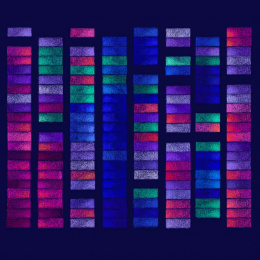Droplets & Barcodes: Screening for Combination-Based Therapeutics 4
Droplets & Barcodes: Screening for Combination-Based Therapeutics 4
Jared Kehe, Tony Kulesa
Broad Institute
Let’s say you have a large collection of drugs—say, 100 in total—that you want to test in various combinations. That is, you want to screen combinations of drugs. It would take a lot of time to prepare and test every possible combination of 2 (~5000 in total) and much longer still to test larger combinations (sets of 3, 4, etc.). In fact, this problem grows intractably complex to do using any standard techniques. This new platform enables very rapid preparation of many 1000s of combinations. We put the drugs inside tiny droplets (1 nanoliter each), which then get randomly assorted into a large array of small wells designed to take a certain number of droplets. Droplet also receive a color barcode via a combination of three fluorescent dyes (red, green, and blue), which tells us what droplets were assorted into what well. From here, we can merge the droplets within their well to generate the combination.






